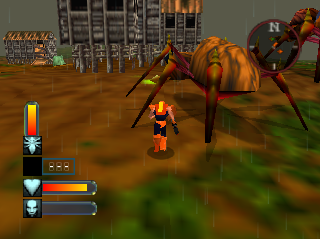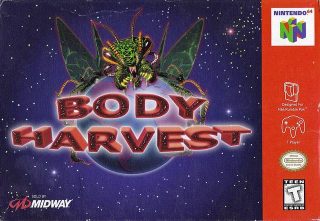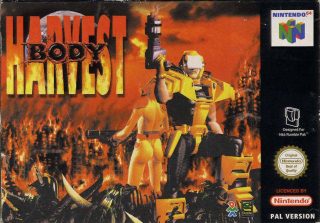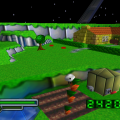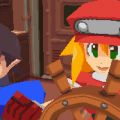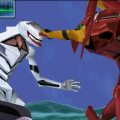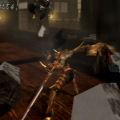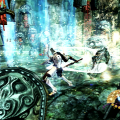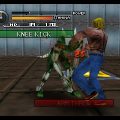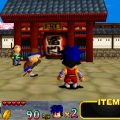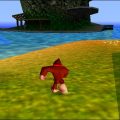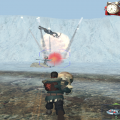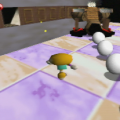by Jerry Fieldsted (Wildcat)
Perhaps you’ve heard of a little game called Grand Theft Auto III? Developed by DMA Design, it was one of the resounding successes last generation, spawning several sequels and becoming one of the most controversial games ever made. Its free-roaming design and reliance on sandbox gameplay allowed gamers to play the game their own way (for the most part), and helped raise the bar for garnering mainstream gaming attention. Rockstar, the publishers of the game, renamed DMA as Rockstar North and the group would become one of the leading western developers of today thanks to this release.
The funny thing is that Grand Theft Auto III did not pioneer these concepts – a little-known Nintendo 64 action game built by the same developers provided the foundation for GTA3‘s acclaim. And the most interesting fact of it all is that Nintendo of all publishers had a hand in its development. The game is called Body Harvest.

Body Harvest (N64)
In 1995, the year predating the launch of the Nintendo 64, the people at Nintendo were recruiting devs to join what they were pegging as their “Dream Team”. This of course included themselves and recently purchased second party Rare, who would both deliver some of the finest games to hit the 64-bit machine, but also featured some prominent third parties such as Gametek, Time Warner Interactive, Acclaim…wait a second…those are a Dream Team? While Nintendo did include some notable names like Midway and Lucasarts, the majority of their “stars” were either budding developers (Angel Studios, DMA Design) or brands long regarded with disdain for their terrible gaming atrocities (Acclaim [who did pull a solid turnaround in quality for the N64, but carried a stigma that had to be washed off over the system’s lifetime], Time Warner, Virgin, Gametek, and so on). Where was Squaresoft, or Enix, or Capcom, or Konami…or ANY Japanese third parties? Despite the blaring omission from their homeland, Nintendo had put the team at DMA Design, riding a high off of their Lemmings franchise, onto their list of notables for one design document shown to them. It featured an insect and a demolished car. Nintendo gave the team the go-ahead to take the concept into a full-fledged game that they would publish.

Body Harvest (N64)
It was a wild four-year ride for DMA Design, as EDGE details in their excellent history of Body Harvest‘s development. To summarize, DMA Design put two years of work into an action game and showed off their progress to Nintendo. Unfortunately for the team, Nintendo was not happy with the way the game was being handled. They sent out several Nintendo staff members, including one producer of the Zelda 64 project, over to Dundee, Scotland to try to rework the project – an RPG overhaul was suggested, of all things (although, considering that the Nintendo 64 was hurting in that department and is considered to be a major reason the console had a lukewarm reception in Japan, it’s not much of a surprise), which DMA apprehensively agreed to. DMA Design and Nintendo made attempts to turn Body Harvest into an RPG, with DMA going to Nintendo HQ in a last-ditch effort to get it done, working next door to the Star Fox team for two weeks. Upon their return, the Body Harvest team discovered that the development of another DMA title, Zenith, was canned in their absence, and now had the opportunity of welcoming that staff into the chaotic Body Harvest cycle. After their addition, the game took on the gameplay it featured today – a third person action/shooter hybrid that enabled its hero to hop into any vehicle around him. Nintendo was not pleased, and dropped the project after three years. Gremlin Interactive bought out DMA Design and released the final product in Europe, while Midway picked it up for America, falling right in between Rare’s Banjo-Kazooie and Nintendo’s The Legend of Zelda: Ocarina of Time and getting lost in the shuffle.

Body Harvest (N64)
For a game with such a tumultuous development, Body Harvest turned out remarkably well. The basic plot is that aliens have come to finally eradicate the human species, which they have been ravaging for over a century. Two soldiers, Adam Drake and Daisy, are sent out in a recently-invented time machine, The Alpha Command Module, in order to go back into the past and wipe out the earlier invasions, saving humanity from its doomed fate. The aliens first arrived in 1916, and returned every 25 years to harvest more food. Adam visits Greece in 1916, Java in 1941, the southwestern United States in 1966, and Russia in 1991, as well as the alien’s planet, fighting swarms of insect-based foes through massive levels filled with NPC’s, puzzles and vehicles. Along the way he picks up better weapons and engages enormous bosses in his time machine, morphed into a battle-ready hovercraft dubbed the Alpha Tank.
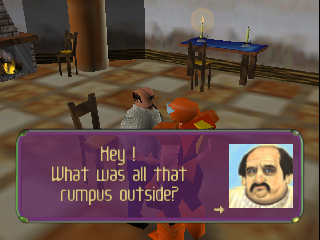
Body Harvest (N64)
Adam Drake is your silent protagonist, a soldier suited up in orange armor and capable of fighting with a wide range of artillery. Despite sticking out like a sore thumb in an oddly colored futuristic battle suit, most people don’t seem to bat an eyelash at his appearance in the four different time zones (beyond noticing that he looks like a soldier).
Daisy is your sidekick, who spends most of the game inside the Alpha Command Module and sends Adam alerts about alien activity, as well as clues to progress. She gets kidnapped in the final area in the game, and Adam has to rescue her in the midst of infiltrating the alien’s base. In marketing materials she carries a rifle, suggesting that she may have been planned to be a playable character at some point. She’s professional and to the point in her dialogue over the communication channel, but speaking with her in the ACM she seems to drop the military pretense and speaks more freely (she comments to Adam about kicking alien ass in Greece the second time you talk to her).
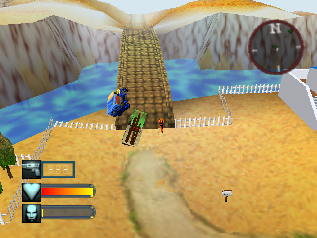
Body Harvest (N64)
You’ll also run into Tomegatherion, a sinister clone created by the aliens from Adam’s spilled blood from the intro. Tomegatherion causes Adam grief throughout the game, and serves as the final boss. With a cheat, you can play as him, although it’s merely a cosmetic change.
The basic gameplay boils down to four major styles – Adam’s standard controls, where he runs around the landscape; his shooting controls, which changes the camera to being behind Adam’s back; indoors, where Adam interacts with NPC’s, switches and treasure containers; and the vehicles, which there are four basic types (which I’ll get to in a moment). For the first, Adam is able to run around freely, using the C buttons to direct the camera and to enter a vehicle (using C-Down). Adam can also swim, but not for long. While these are adequate, there are issues. Adam is a little slow with his running speed, and there are times where it feels necessary to shove the analog stick as far as it will possibly go for him to get any sort of momentum going. The swimming limit was obviously done to prevent overzealous players from breaching the game’s maps too soon, but the time limit is a bit too short. It also can be all too easy to slip down a hill into a pond or river and die because of the lack of nearby shoreline.
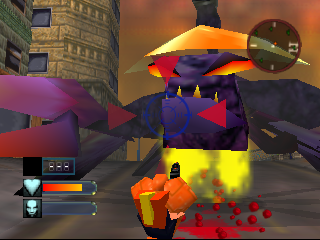
Body Harvest (N64)
Holding down the R button will bring up the game’s combat controls. Adam stands stationary, and can aim by moving the Control Stick. Changing weapons is done with the Control Pad, and Adam can roll out of the way or perform a quick-turn roll that flips Adam around to attack foes flanking him, which is the only way he can move while in combat. The action aspects are excellent for its time, with an auto-aim that works fairly well (which makes the shoddy aiming in GTA3 somewhat perplexing) and a camera approach more than suitable for blasting. Adam will quickly drop his weapon by letting go of R in case you need to beat a hasty retreat, which is also a plus, although it takes him a second to start moving. Health can be regained by finding hearts stored away in barrels, drawers and chests in buildings, or may be dropped by some of the nastier enemies. Adam’s pistol has infinite ammo, but is by far his weakest weapon. Better guns can be found indoors, and plucky players may be able to create a special alien weapon to wield for each time period if they find three weapon crystals. These are pretty devastating.

Body Harvest (N64)
When Adam is inside a structure, the outside world literally freezes. Once Adam returns to the battle, it’ll be as if he never left (although he will likely take a couple cheap shots before the player can react). Aliens will not attack you inside, and Adam is unable to fire off his weapons. These sanctuaries provide Adam with clues (through NPC’s and books), items (new weapons, weapon crystals, alien artifacts, ammo, fuel and health), and occasional puzzles. Indoor controls are both slow and awkward – the differentiation of the standard scheme for these segments seems pointless. For some reason DMA Design incorporated sidestepping into the mix, which is the only time Adam can do so. It does little more than enable players to perform some ridiculous dance moves. Adam can only walk here, too, which forces these excursions to take longer than need be. The rewards counteract these downsides, but just barely.

Body Harvest (N64)
Lastly, there are the vehicles. Adam can operate cars, trucks, motorcycles, helicopters, airplanes, boats, and tanks, among others, and the list of potential rides shifts with every time zone thanks to the increase in technology. Cars, trucks, boats, and tanks control similarly, while planes and helicopters have a little more technicality to piloting them. While Adam is inside of a vehicle, he will not take any damage from the alien horde’s strikes – the car has its own life bar, and once it’s empty, it will explode (which will hurt, if not kill, Adam). Vehicles also require fuel to operate, and once they’ve been run dry, they will need to be refueled. A player who has explored any of the interiors thoroughly enough will likely have found spare fuel in their searching, and can enter the pause menu to get the vehicle up and running again. A land-based vehicle will slowly drain health if it is accidentally plunged into water, and Adam will have to make a quick escape before it explodes and try to get to shore before dying himself.
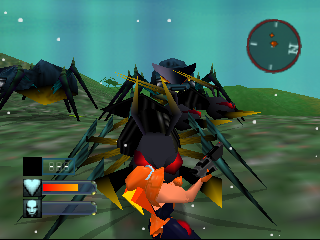
Body Harvest (N64)
Fans of the GTA series will find their handling to be a little similar. Adam can shoot some of his weapons from the driver’s seat, and some vehicles have their own special weapon to use. Serving as a second life bar and giving Adam some much needed speed, you will often see vehicles as a godsend. They aren’t flawless, though – don’t expect precision driving here, as the cars will turn a little slow (as they do in GTA3), with larger vehicles requiring more time to turn. Motorcycles on the other hand are fast and loose, and are arguably the most fun to drive. Expect yourself to fly off a cliff a time or two, though. Airplanes and helicopters incorporate a third dimension into their controls, making them a little more complex. Planes require you to lift off, which the player can do by holding back on the control stick to gain height. To land, you press forward. Planes are a little loose-feeling, but are serviceable. Helicopters use A and B to climb and descend, respectively, and are a lot like motorcycles – they are faster than planes and tend to get themselves into trouble easily. Boats are like cars on water, but they seem to turn better than the majority of the game’s other vehicle options.

Body Harvest (N64)
Your antagonists do more than serve as mere fodder for your shots. Beyond watching his health, Adam has to attempt to save as many people as he can in each level, with a limit as to how many can die from being munched by the enemy, or by being murdered by Adam’s blasts or his poor driving. If it’s surpassed, Adam will perish in the resulting lightning storm the aliens unleash on the area. While Adam is free to roam around, Harvester clusters will beam into villages, towns and city blocks and attempt to ravage the population, and the game points out these attacks to you through an understandable radar and a directional arrow. Most of the time there’s only a couple of civilians wandering about outside, but the aliens have the capability to destroy most of the game’s dwellings, providing an early case of destructible environments (if Adam has powerful enough weaponry, he can also deconstruct homes and offices, although it works very much against his favor to do so) and forcing out several potential snacks. Once cleared, the area is saved and Adam may move on. These are the tensest parts of the game, as Adam must subdue the threats while trying to avoid accidentally ripping apart an innocent, counteracting his mission. The key is to target the Harvester, the alien responsible for devouring the humans its blobs collect to share with its brood. Once it is slain, the minor enemies flanking it will likely abort their initial mission of demolition and turn their attention onto Adam, making it a wise choice of action. Occasionally the game throws out a rescue mission for Adam to accomplish, and for the most part these escort missions are not too frustrating. These survivors manage to have adequate AI scripts powering them to their destination precisely, which is very nice to see. All in all, this is the meat of the game, and is the most thrilling.

Body Harvest (N64)
Aliens come in many forms – from small to enormous. As the game gets further along, it unveils newer and more dangerous members of its armada. Enemies will spawn outside of Harvester groups as Adam travels the landscape, and players will likely find that a vehicle will be the best way of traversing safely. Adam can auto-aim while driving (although his turning radius is limited), and the vehicle’s added durability makes the in-between encounters less of a liability as Adam plunges deeper into the level. Each time period has four sectors to explore, with a Processor guarding the entrance to the next area. These guardians can throw out some nasty projectiles at you, so it’s advisable to gear up with a vehicle that can dish out stronger ammo than Adam’s guns. Once defeated, a save beacon plummets into the ground (which for some unlucky players, can land on Adam if he’s in the wrong spot and send him reeling, likely into the middle of the ocean to drown), giving Adam a chance to save his progress and to beam between earlier beacons in case the player wishes to backtrack for items missed.
In between shooting aliens, the game will throw in side-missions at the player. These can vary from stage to stage; for example, in the first part of Greece, the alien invaders ignite several structures in a town. It’s up to Adam to head back to the fire department in a neighboring village and commandeer a fire engine to put out the flames within 3 minutes. These attempts to break up the gunplay monotony are welcome, but can be a little annoying if you’re trying to tear through the game quickly. You’ll also have to resort to the map often to see objectives and to get your bearings thanks to the sterile environment – there’s little in the form of landmarks to use as a guide. The map is serviceable, but could have used a little more color to differentiate it more.

Body Harvest (N64)
Once you’ve defeated all of the area’s Processors, the Alpha Command Module will morph into the Alpha Tank and Adam will have to utilize its special talents to take down a large boss. The Alpha Tank is essentially a hovercraft, and drives like one, far more floaty than the majority of the game’s other vehicles. This does work to its favor, as the player is able to strafe in circles easily, enabling some run-n-gun tactics. As you fire your cannons at the beast, additional ammo and health may pour out of it – the Alpha Tank uses its own special ammo types, and are switched like Adam’s artillery with the Control Pad. These are usually long entanglements that require some shooting skill and a fair bit of patience. Adam can bump into the mountains bordering the arena, which can force him to stop moving, a dangerous possibility. Running into the boss is also a risk, and is likely to happen more often than ramming the sidelines. If Adam fails, the hovercraft will explode, leaving Adam to suffer an agonizing salvo and quickly expire. These can be entertaining, but ultimately are a bit of a drag compared to most of the game.

Body Harvest (N64)
DMA Design began work on this game in 1995, and it shows most in the game’s antiquated graphics. It wasn’t impressive in 1998 when it came out, and it hasn’t aged well at all. Low-poly models, lightly decorated backdrops and heavy reliance on repeating textures hamper the game’s visual style significantly. The game’s outdoor civilians are hideously rendered with about 10 large polys making up their entire frame. Indoors, the NPC’s fare a tad better. In battle, mostly in large skirmishes or fighting immense foes, the game’s frame rate will take a small nosedive. It’s another good reason to enter vehicles, as Adam has extra protection and can get further away from the programming anarchy in the hopes it’ll stabilize. In short, this game is no visual masterpiece, and gamers accustomed to today’s graphical wonders will be taken aback by Body Harvest‘s look.

Body Harvest (N64)
While graphically unimpressive, the game’s audio is superb. Stuart Ross and Allan Walker provided the game’s score, and their piano-driven interior and exterior safe (as in, no aliens) pieces are beautifully done. The music has a very suspenseful edge to it that underlies Adam’s tranquility, reminding the player that while it seems peaceful indoors, it’s anything but. In combat, the music becomes more ominous and ditches the piano for more action-driven instrumentation, providing a great backing to the gunplay. Another nice trait is that the outdoor themes rotate as you go into buildings and back out, giving some welcome diversity to the proceedings. If anything, the DMA Design musicians and sound team need to be commended for their hard work in Body Harvest, as the songs sound better than many other N64 titles in terms of their rich sound. The effects are good, with plenty of sci-fi oriented bangs and booms. The only spoken dialogue is muffled screams from both the human and alien sides of the conflict, which suffice. A civilian’s death cry is believable, loud and startling, and will quickly alert the player of their demise (and hopefully not be followed by more!).
Body Harvest is an overlooked game that deserves more recognition. It may not have much visual appeal, it’s a bit sloppy and has its odd little quirks, but underneath its many flaws is an enjoyable action game that tested the waters of the open-ended world exploration Grand Theft Auto III refined. If you can shrug off its poor graphics and can give it some diligence, you may find the same excellence that I have found.
Cameo in Grand Theft Auto: San Andreas
Rockstar North tossed out a small remembrance of their past with this mission, which sends CJ out to steal a Combine Harvester from a pack of survivalists in Flint County. In Body Harvest, there was a part where Adam could use the same kind of vehicle to shred up zombies in Siberia. CJ can also dismember pedestrians in a similar manner with his Harvester, leading credence to the cameo. Furthermore, this mission is actually called “Body Harvest.” Beyond this, however, it’s the only mention of the game in the series that took its concepts mainstream.
Thanks to Aganar, ReyVGM and Splatter for their help with the screenshots and other assorted stuff.
Links:
Edge Online The Making Of: Body Harvest Edge looks back on the development of Body Harvest, interviewing some key staff and providing excellent insights to DMA’s initial collaboration with Nintendo.
GiantBomb Page for Body Harvest Better than the Wikipedia page for some general reference to the game’s mechanics and background.
Mike Dailly’s Body Harvest Flickr Collection Former DMA Design member Dailly’s collection of Body Harvest assets.
